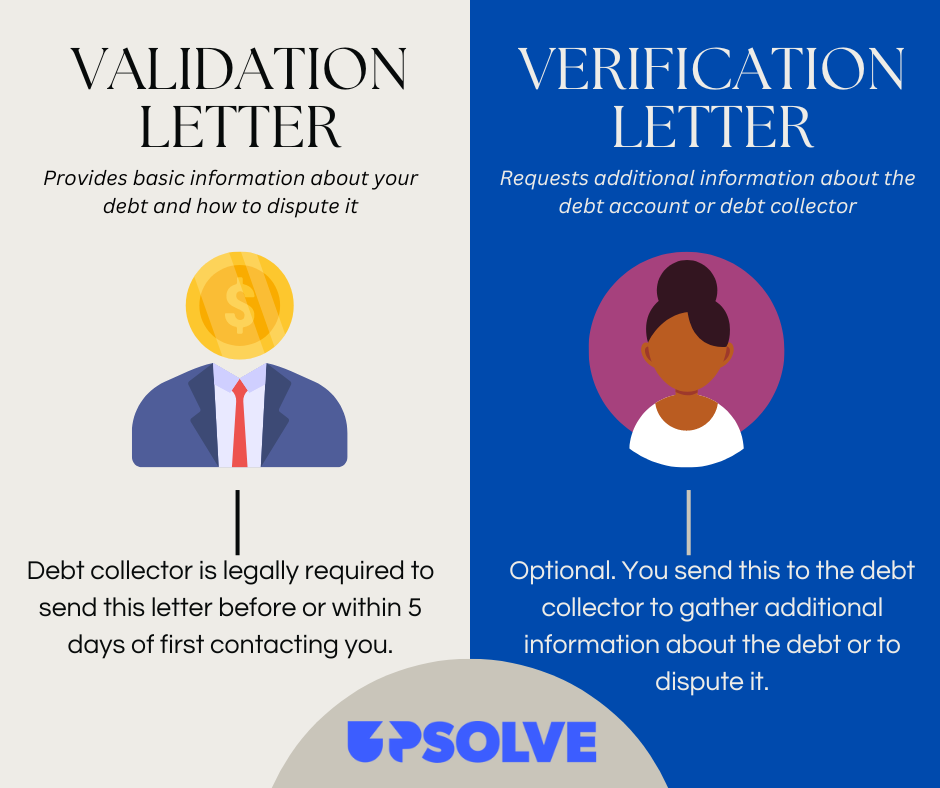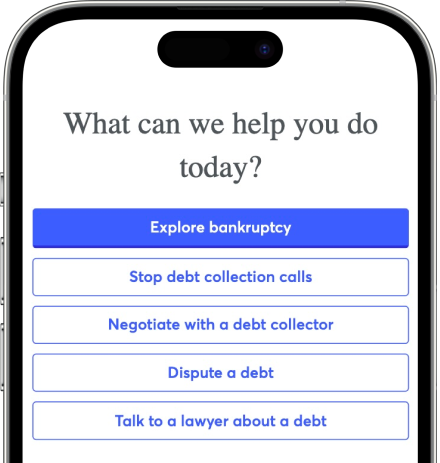How To Deal With Halsted Financial Services
Upsolve is a nonprofit that helps you get out of debt with free debt relief tools and education. Featured in Forbes 4x and funded by institutions like Harvard University so we'll never ask you for a credit card. Get debt help.
Halsted Financial Services is a debt collection agency with a primary focus on past-due consumer debts, such as personal loans, credit cards, and medical bills. If Halsted Financial Services calls you or sends you letters to collect a debt, ask them to validate the debt. This article explains how to verify a debt and explores your options, such as contesting the debt, negotiating a debt settlement, or ignoring the debt (not advised).
Written by the Upsolve Team.
Updated March 4, 2024
What Is Halsted Financial Services?
Halsted Financial Services LLC, based in Skokie, Illinois, is a third-party debt collector with clients that include healthcare providers, credit card companies, and payday loan providers. Halsted primarily collects past-due accounts on behalf of creditors and lenders.
Why Is Halsted Financial Services Contacting Me?
If Halsted contacts you, you may have an unpaid debt with an original creditor.
Halsted operates differently than most debt collecting agencies. Most debt collectors buy charged-off debts from original creditors and try to collect the debts for their own profit. Instead, Halsted usually collects debts on behalf of original creditors, earning a percentage of each collected debt account. Halsted encourages the consumers they contact to pay them directly using their online payment system.
Is Halsted Financial Services Legit?
Yes, Halsted Financial Services is a legitimate debt collector. Halsted is accredited with the Better Business Bureau (BBB), which currently gives the company an A- grade. The company’s customer rating is considerably better than most other collection agencies. Customers rate it 4.38 out of 5 stars, with more than 240 reviews.
Despite this rating, more than 271 consumer complaints were filed against Halsted in the past three years, while the Consumer Financial Protection Bureau’s (CFPB) Consumer Complaint Database received more than 650 complaints since December 2011.
Consumer complaints against Halsted Financial Services allege improper disclosure of debt information to others, trying to collect a debt not owed, threatening jail for not paying a debt, and impersonating law enforcement.
A debt collector making these statements or taking these actions could be in violation of the Fair Debt Collection Practices Act (FDCPA). This federal law prohibits third-party debt collectors from harassing consumers or making misleading and threatening statements. If you believe Halsted violated the FDCPA by trying to collect a debt from you, you can file a complaint or sue them for monetary damages.
Note to reader: These reviews and complaints highlight relevant issues, but they may not represent all consumers’ experiences.
How Do I Know if I’m Being Scammed?
Though Halsted Financial Services is a legitimate company, fraudsters can use real company names to trick people into sharing personal information or sending money.
To avoid being the victim of identity theft, ask anyone trying to collect a debt from you to validate the debt. Even better, if you think you’re on the phone with a scammer, hang up. The longer you talk to them, the more opportunities they have to convince you to give personal information or send money.
To learn more about debt collector scams, read Upsolve’s article How To Avoid Debt Collector Scams: 8 Red Flags.
Do I Have To Pay Halsted Financial Services?
You might need to pay the debt, but you should first confirm there isn’t a mistake or mix-up. When creditors partner with third-party agencies to collect debt, errors can happen. For example, debt collectors may try to collect a debt that’s already been paid or belongs to someone else. This is why it’s important to validate that Halsted can collect the debt from you and that the amount is correct.
If Halsted can’t prove the debt is yours, then you don’t have to pay them and they should stop contacting you if you tell them in writing to stop.
If they can prove it’s yours and they own it, you have to decide what to do next.
Upsolve Member Experiences
1,997+ Members OnlineStep 1: Send a Debt Verification Letter
Within five days of contacting you for the first time, Halsted should send you a debt validation letter (sometimes called a validation notice). If they don’t, you can send them a debt verification letter. The purpose of these letters is to obtain more information about the debt to confirm it’s valid.

In addition to information about the debt account, the validation letter should contain information about how to dispute the debt if you disagree with it. Read your validation letter carefully for information about the 30-day deadline for disputing the debt. If you decide to dispute the debt within these 30 days, Halsted must cease collection activity until the dispute is resolved.
If Halsted can’t verify the debt, you don’t need to pay the debt and you can tell them to stop contacting you. In this situation, it’s a good idea to check your credit report and credit score for any errors.
If Halsted can verify the debt, you must decide what to do next.
Step 2: Decide What To Do Next
Though this can be stressful, remember that you have options. You can dispute the debt, try to settle the debt for less than what you owe, or ignore the debt (not recommended).
Option 1: Dispute the Debt
If Halsted has validated the debt but you disagree with the amount or don’t believe the debt is yours, you can dispute it.
At this point, double-check your credit report for errors. If you see a mistake on your credit report, contact the credit bureau (TransUnion, Experian, or Equifax) reporting it and ask them to remove the error from your credit report by sending a credit dispute letter. The Fair Credit Reporting Act (FCRA) gives consumers the right to dispute errors on their credit reports.
Option 2: Negotiate the Debt and Make a Settlement Offer
Halsted is often willing to settle a debt for less than the full amount. Debt collectors like Halsted only get paid if you pay them, and they know you may not be in a financial position to pay off the debt completely. So you may be able to settle your debt for 40%–60% of the original amount. Remember, they want to close collection accounts, so they have an incentive to work with you to make it happen, even if it means they earn less.
You can start a debt negotiation by writing a debt settlement letter. Many people make an initial offer of 25% or 30% of the original debt amount. Expect some back and forth, though. It’s common to agree on something around 50% or 60%.
To learn more about the negotiation process, read Upsolve’s Guide to Beating Halsted Financial Services.
Can You Negotiate Every Past-Due Debt?
Most consumer debts — credit card bills, payday loans, and medical or utility bills — are negotiable, especially if a third-party debt collector is trying to collect them. Many debt collectors will negotiate a settlement with the consumer. Even the IRS has a special process for settling federal tax debts for less than the full amount.
Unfortunately, some consumer debts are non-negotiable. Two common examples include car loans and home mortgages. These are secured debts, which means the car or home “secures” the loan amount as collateral. Because of that, the lender can take the property back if you don’t make your loan payment.
Federal student loans are also non-negotiable. But if you’re having trouble paying, you can look into student loan forgiveness programs or income-based repayment plans.
Option 3: Ignore the Debt (Not Recommended)
While ignoring the debt is technically an option, it’s not recommended and will make your financial situation worse in the long run.
What Happens if I Ignore Halsted Financial Services?
Ignoring Halsted can come with serious negative consequences, including:
More debt due to interest, fees, and legal costs
A lower credit score
A possible lawsuit, which can result in a court order for wage garnishment
Continued debt collection efforts — debt collectors rarely give up when ignored
Ignoring debt collectors is never a good idea. Debt collectors can still take legal action against you as long as the statute of limitations hasn’t passed. Even if it has, a debt collector might still try to sue you or continue debt collection attempts, like phone calls and letters.
This doesn’t sound like the most encouraging news but keep your head up. Knowledge is power. To learn more about how to settle a debt or fight a lawsuit, read Upsolve’s Guide to Beating Halsted Financial Services.
Can Halsted Financial Services Sue Me?
While getting sued by a debt collector is a possibility, Halsted is unlikely to sue you because they don’t own your debt.
What influences a debt collector’s decision to sue? They’ll usually consider:
The size of the debt
How much it’ll cost to sue you
If the debt collector can collect interest, court costs, and attorney fees
How easy it would be to get a court order to garnish your wages
If you have any other unpaid debts
How old the debt is and what its statute of limitations is
Applicable state laws relating to creditor rights and contracts
If Halsted decides to sue you, you’ll probably learn of the lawsuit when you’re served a copy of the complaint and summons by mail or in person. Even if you disagree with the lawsuit, you still need to respond to the complaint or you risk losing automatically.
You don’t have to hire an attorney to respond to the complaint. You can find more information by reading Upsolve’s Guide to Beating Halsted Financial Services.
Let’s Summarize…
Halsted Financial Services is a debt collection company that works for creditors to collect past-due consumer debts like healthcare and credit card bills and personal loans. If Halsted tries to collect a debt from you, make sure they validate the debt before you pay anything or take further action. If the debt is valid, try settling the account for less than the full amount.

